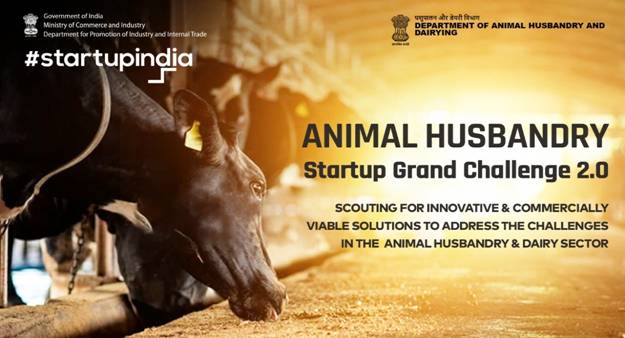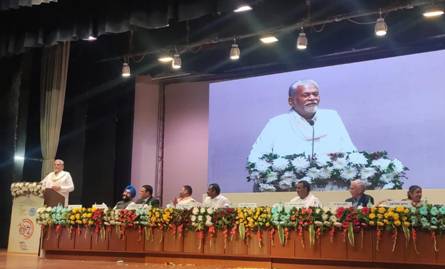Ministry of Fisheries, Animal Husbandry & Dairying
Second edition of ‘Animal Husbandry Startup Grand Challenge’ launched
The aim is to scout for innovative and commercially viable solutions to address six problems faced by the animal husbandry and dairy sector
A winner will be awarded with Rs 10 Lakh and a runner-up with Rs 7 Lakh cash for each of the 6 problem areas
The challenge is open for application on the Startup India portal – www.startupindia.gov.in
प्रविष्टि तिथि:
13 DEC 2021 6:37PM by PIB Delhi

The Department of Animal Husbandry and Dairying, in partnership with Startup India, launched the second edition of ‘Animal Husbandry Startup Grand Challenge’ at an event celebrating ‘National Milk Day’ in Anand, Gujarat to commemorate the birth centenary of Dr. Varghese Kurien. The event was organised in the gracious presence of Union Minister of Fisheries, Animal Husbandry and Dairying, Shri Parshottam Rupala, Union Minister of State of Fisheries, Animal Husbandry & Dairying and Information & Broadcasting, Dr. L. Murugan, and Minister of State of Fisheries, Animal Husbandry & Dairying, Dr. Sanjeev Balyan.

The first edition of the startup grand challenge was launched by Prime Minister, Shri Narendra Modi, on 12th September, 2019. Animal Husbandry Startup Grand Challenge 2.0 has been launched by Union Minister for Fisheries, Animal Husbandry and Dairying, Shri Parshottam Rupala, to scout for innovative and commercially viable solutions to address six problems faced by the animal husbandry and dairy sector. The challenge is open for application on the Startup India portal – www.startupindia.gov.in – to all startups for the following problem statements:
- Cost-effective, Long-term, and User-friendly Alternatives for Storage and Supply of Semen Doses
Problem Statement in Detail
- Maintenance of cold chain to supply semen doses from Semen Production centres till the farmer’s house where semen is used to inseminate the farmer’s cow/ buffalo, is the backbone of AI delivery system in India
- Liquid Nitrogen and liquid nitrogen containers are used to store and transport semen doses. The loss of LN2 during the storage and transportation is high, leading to an increase in the cost of cold chain maintenance
- LN2 is a by-product of steel and oxygen industry. So, wherever these industries are available, the cost of LN2 is relatively low but in other parts it is on the higher side
- Inappropriate handling of LN2 may lead to health risks
- LN2 storage containers are bulky and heavy, so movement of these containers requires excessive manpower
Expectations from the Solution
- Some alternate cost effective, long duration, and user-friendly means of storage and transport of Semen Doses (cryopreservation) may be explored and popularised
- The storage container may be designed in such a way that it should be small and easy to carry
- Development of Cost-effective Animal Identification (RFID) and Traceability Technology
Problem Statement
- Animals are identified using polyurethane tags with a unique identification number. It has been estimated that 5-10% of the tags are lost as these tags are applied externally. It is also difficult to read identification number. Therefore, it is the need of the hour to give a permanent identification to cattle and buffaloes.
- The technology using Radio Frequency Identification (RFID) among animals is presently very costly. The cost ranges from INR 50 to INR 100, and the reader costs are also huge, ranging from INR 15,000 – INR 20,000. RFID is a permanent identification number as it is applied under the skin and it cannot be removed easily. As the technology is costly, it is not used on farm animals in Indi
Expectations from the Solution
Entrepreneur may develop cost effective RFID identification systems for identification of farm animals, especially cattle and buffaloes. Cost reader may also be reduced substantially.
- Development of Heat Detection Kits
Problem Statement
- The most important limiting factor in artificial animal reproduction is the improper detection of estrus in cows or heifers. The traditional form of estrus detection has been visual observation. However, this method is tedious and incurs high labour costs. Among the signs linked with estrus in dairy cows, standing to be mounted is the most reliable indicator of estrus.
- Buffaloes have silent estrus. Therefore, it is difficult to detect when they are in heat, and this is a major reason of long calving interval in case of buffaloes.
Expectations from Solution
- Heat mount detectors (HMD) have become more popular in the dairies in western countries for detection of estrus. Pedometers/ neck collars have been used to study physical activity and thereby determine the time of estrus, but again, these are costly technologies.
- Entrepreneur may develop cost effective technology for detection of heat among buffaloes and/ or cattle.
- Development of Pregnancy Diagnosis Kits for Dairy Animals
Problem Statement
- In AI programmes, pregnancy diagnosis is successfully done at 70 to 90 days of pregnancy, through rectal palpation. Rectal palpation is done by a veterinarian, or technicians in the presence of a veterinarian.
- It is not possible for farmers to detect pregnancy at an early stage (at about 30 days of pregnancy)
Expectations from Solution
- Pregnancy diagnosis kit to be developed based on the blood protein.
- Entrepreneur may develop pregnancy test kits on the lines of Alertys Ruminant Pregnancy Test kit marketed by IDEXX and establish facility for its production. This will reduce the cost of management of animals substantially.
- Improvement of existing milk supply-chain from village collection centre to the dairy plant
Problem Statement
- There is no mechanism of tracing and identifying a village from where milk is being collected by a collection centre. Therefore, all villages are to be coded across the country.
- There is no information about the milk route used (by a tanker/ truck) from the collection centre to the BMC (Bulk Milk Cooling) centre. Therefore, all milk routes in cooperative and private sector dairy processors are to be coded.
- There is no information as to which milk tanker/ milk transporting vehicle delivered the milk from the collection centre to BMC centre. Therefore, all milk tankers/ milk transporting vehicles are to be coded and GPS-enabled.
- There is no information as to which BMC centre chilled the milk. Therefore, all BMC centres are to be coded.
- There is no information as to which milk tanker transported that chilled milk before it was delivered to a dairy plant.
- There is no information as to which dairy plant accepted that milk. Therefore, all dairy plants are to be coded. Further, in each of the dairy plant, all milk silos, milk pasteurizers, milk packing machines, all processing batches/ processing shifts, etc. are to be coded. All dairy product making process lines are to be coded of that plant, if any.
- Based on the above geo-codes, a generic and unique code needs to be generated by the SAP-based solution provider, which is to be labelled in the pouches of the pasteurised milk/ dairy products like dahi, paneer etc.
Expectations from Solution
- Reduction in handling loss
- Preventing handling loss/ curdling loss of raw milk due to reduction in overall travel time of milk; reduction in loss of milk solids
- Increased sales due to improved quality of raw milk and increase in opportunity to convert liquid milk to value added products, leading to higher returns and increase in dairy exports
- Development of Low-cost Cooling and Milk Preservation System and a Data Logger
Problem Statement
- In hilly areas the milk is carried in milk cans of 40 litre and 20 litre capacities to the roadside DCS. This may take up to 2 hours to reach milk collection centre from the time of milking. Similarly, in deserts, river islands in delta areas, and other remote areas, farmers face difficulty in cold chain to reach the collection centre, causing deterioration of the quality of milk and economic loss. As per FSSAI regulation, milk should be cleaned once it is drawn from the udder of the animals. There is need for innovation on low-cost milk preservation system in small sized cans/containers (5 litres, 10 litres, 20 litres).
- Data Logger: As part of monitoring of critical parameters in the primary production process, software-based auto data capturing system had been introduced by some cooperatives. This establishes complete traceability in the primary production which is mandatory as per FSSAI. It is basically an internet-based, real-time management of BMCs with enhanced reporting, pilferage reduction, & tamper proofing features, for improved monitoring and efficiency of BMC (Bulk Milk Cooler). The cloud-based system helps in preventive diagnostics & remote monitoring of various parameters of the BMC such as temperature, volume, Cleaning-in-Place (CIP) events, efficiency, malfunctioning, and potential misuse. SMS alerts like information alerts (summary alerts, compressor ON/ OFF, scheduled proactive maintenance, power source status, etc.) and critical alerts (under/ over cooling, maintenance alerts, etc.) will be provided over mobile phone to various stakeholders. Daily/ Weekly/ Monthly reports of BMC operation and related milk storage data will also be available over mobile phone and internet. The system also captures all farmer-wise procurement data at cluster societies directly from the milk analyser, as well as from BMCs, which can be linked to the software system.
Expectations from Solution
- Low-cost village level cooling system e.g., in small capacity milk cans shall help in better quality products, compliance of FSSAI regulations, higher income to farmers, etc.
- Smart data logging device in milk tanker, bulk vending machines, milk cans at a graded cost shall help in greater monitoring of product quality and corrective actions.
The winning startups of the ‘Animal Husbandry Startup Grand Challenge 2.0’ shall be provided with the following incentives:
For each of the 6 problem areas, a winner to be awarded with INR 10 Lakh and a runner-up with INR 7 Lakh each as cash prizes.
Up to 12 winners to get incubation. The incubator would be responsible for virtual incubation of these startups for up to 3 months, mentor matchmaking, lab facility for POC development and testing facilities (on case-to-case basis), conducting business and investor workshops, and tracking the activities of the startups for up to 9 months after the completion of the program.
Up to 6 virtual masterclasses (one for each problem statement) to be organized for providing mentorship to all startups and innovators who will apply for the challenge.
A dedicated mentor from the Department of Animal Husbandry and Dairying would be assigned to each winner for 6 months.
The products/ solutions of the winners of the program would be showcased at Krishi Bhawan, in front on Minister’s office and the Secretary office, in New Delhi to ensure maximum visibility.
A virtual demo day meet would be organized for the top 30 startups selected from the applicant pool, across problem areas. These startups shall get the following opportunities:
- To pitch in front of an audience constituting officials from Ministries, Government Departments, Cooperatives, Corporate bodies, Investors, etc.
- Showcase their product/ services at the individual virtual booths provided to them
- Get access to pilot, pilot, gain procurement orders, and funding
***************
MV/MG
(रिलीज़ आईडी: 1781031)
आगंतुक पटल : 2561
इस विज्ञप्ति को इन भाषाओं में पढ़ें:
हिन्दी